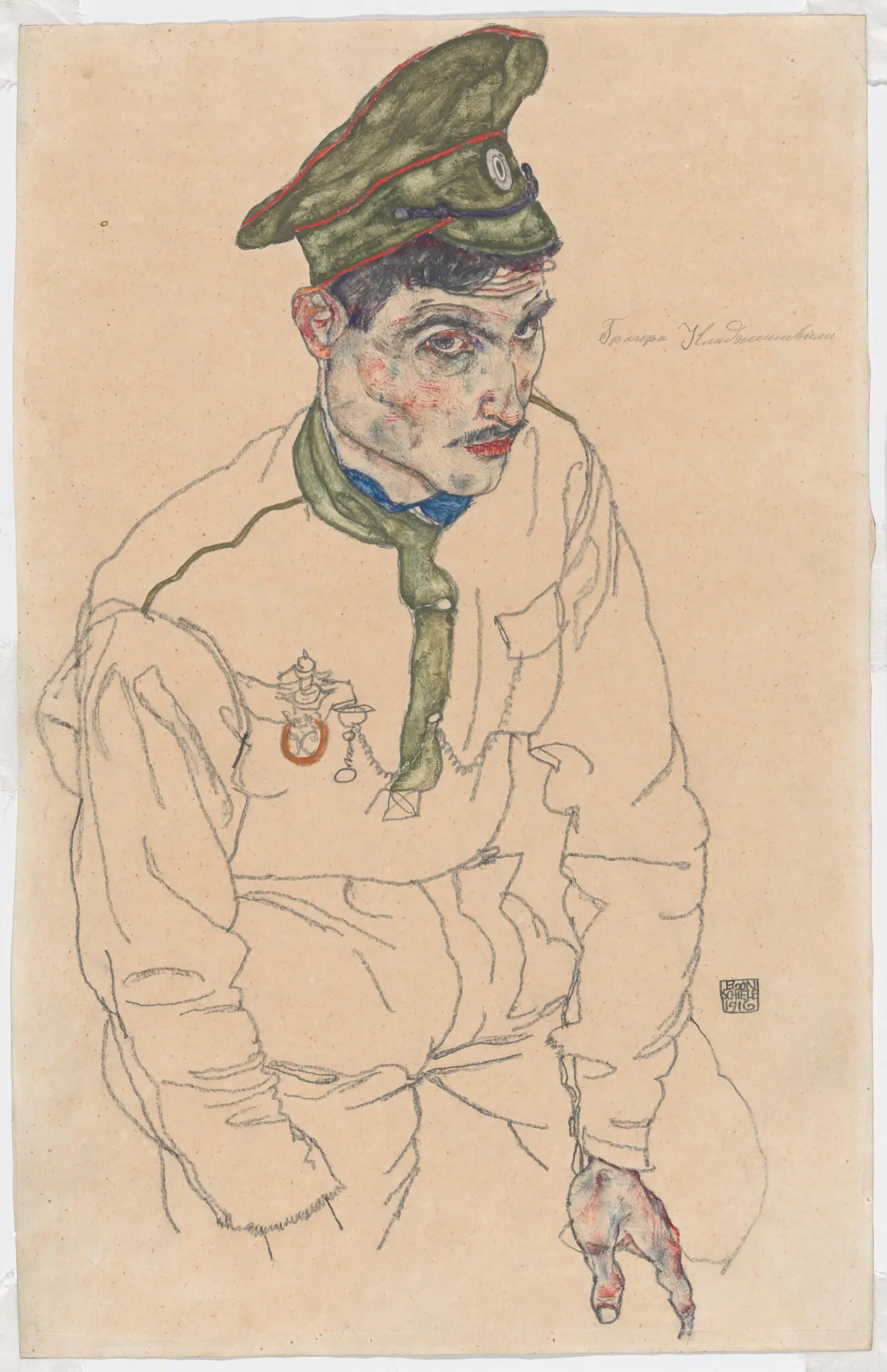News:
Chicago Museum Says Investigators Have No Evidence Art Was Looted
By Graham Bowley and Tom Mashberg
In a court filing, the Art Institute of Chicago fought Manhattan prosecutors’ efforts to seize an important Egon Schiele drawing, denying that the Nazis had stolen it.

“Russian War Prisoner,” a drawing by Egon Schiele from 1916 that is now held by the Art Institute of Chicago.
The Art Institute of Chicago has rebuffed an attempt by New York investigators to seize an Egon Schiele drawing in its collection, asserting in a strongly-worded 132-page court filing that the investigators have produced no evidence that the artwork was looted by the Nazis as they claim.
The drawing, “Russian War Prisoner,” was purchased by the Art Institute in 1966. It is one of a number of works by Schiele that ended up in the hands of museums and collectors and have been sought by the heirs of the collector Fritz Grünbaum, a Jewish cabaret entertainer from Vienna who was murdered in a Nazi concentration camp in 1941.
In a court filing in February, the Manhattan district attorney’s office accused the museum of ignoring evidence of an elaborate fraud undertaken to conceal that the artwork had been stolen by the Nazis on the eve of World War II.
But the museum in its filing in New York Supreme Court on Tuesday argued that the drawing had legitimately passed from Grünbaum to his sister-in-law, who had sold it to a Swiss dealer after the war in 1956.
“There is no evidence at all — none — that the Work was ever physically seized by the Nazis,” the museum said in its court papers.
Megan Michienzi, executive director of public affairs at the Art Institute, said in a separate statement: “Our response provides specific details of the extensive evidence, documentation, and research that specifically refutes the allegations made by the Manhattan District Attorney. The evidence clearly demonstrates this work was never looted and was legally acquired, and we will continue to advocate for our lawful ownership of this work.”
The institute is the lone holdout among eight museums and collectors who received similar turnover warrants in recent months and returned their own Schiele works to the Grünbaum heirs.
In a statement, the office of the chief of the Antiquities Trafficking Unit in the Manhattan district attorney’s office, Matthew Bogdanos, said, “We will respond in court.”
At the center of the dispute is the question of what happened to the drawing when it was deposited by Grünbaum’s family at a storage facility in Vienna in 1938. Investigators have maintained that this was tantamount to surrendering it to the Nazis, who they say controlled the warehouse. But the museum argued that while the storage company had been “affiliated” with the Nazi regime, it “also provided lawful storage and moving services to Jewish families” including Grünbaum’s sister-in-law, Mathilde Lukacs.
Another disagreement centers on the credibility of the account given by the Swiss dealer, Eberhard Kornfeld, who said he bought the Schiele works from the sister-in-law after she had inherited them from Grünbaum. He later sold many of the works, including “Russian War Prisoner.”
The New York investigators have taken aim at Kornfeld’s account, putting forward detailed evidence in their own filings that they said show the provenance documents Kornfeld produced contained forged signatures or alterations made after he came into possession of the Schieles.
But the Art Institute said there was every reason to believe his account that stated he had received the work from Lukacs and that the passing of the drawing into his hands had been a good faith transaction.
In two federal court cases related to the Grünbaum claims, justices have ruled that the heirs came forward too late to lay claim to the work. One of the federal court opinions also described Kornfeld’s account as credible.
But a New York Supreme Court ruling from 2018 found that Grünbaum had never sold or surrendered any of his works before his death, and that they were indeed looted by the Nazis, making his heirs their true owners.
Grünbaum signed a power of attorney in 1938, while in a Nazi concentration camp, that gave his wife control of his assets, according to officials. He was murdered in 1941 and his wife was killed a year later.
In the New York state court case, the judge rejected the idea that Grünbaum had voluntarily transferred the artworks during his lifetime to any heir, including his sister-in-law, and that therefore any future sale of art to Kornfeld would have been invalid. “A signature at gunpoint cannot lead to a valid conveyance,” he wrote.
The museum argued against this interpretation, asserting, among other things, that the art was marital property and that Grünbaum wife’s ownership interest was not the result of the power of attorney, whether it was coerced or not.
Those who have already returned Grünbaum works include the Museum of Modern Art and the Morgan Library & Museum, both in New York; the Santa Barbara Museum of Art in California; Ronald S. Lauder, president of the World Jewish Congress and a longtime advocate of Holocaust restitution; the estate of Serge Sabarsky, a well-known art collector; the Carnegie Museums of Pittsburgh; and the Allen Memorial Art Museum at Oberlin College.
Schiele, an Austrian Expressionist, was born in Austria in 1890 and died there at the age of 28. Known for the intensity of his strokes and fine sketching, Schiele was declared a degenerate artist by the Nazis.


